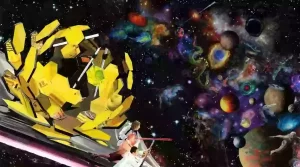NASA’s JWS Telescope captured, the groundbreaking image of Birth of a Young Star

The James Webb Space Telescope, an emblem of human ingenuity, continues to captivate our imagination with its latest revelation. This celestial wonder, captured in a single image, unveils the dramatic birth of a star, offering a glimpse into the cosmic origins of our universe. Join us on this cosmic odyssey as we explore this extraordinary revelation.
A Cosmic Miracle Unveiled
The vast expanse of the universe, a star is born, and the Webb Telescope is there to witness it. This image captures the awe-inspiring moments following the birth of a celestial entity, a phenomenon that has intrigued humanity for eons.
Herbig-Haro Objects: Cosmic Signposts
The image showcases a Herbig-Haro (HH) object, HH 211, a luminous region formed around newborn stars. These cosmic signposts are born when high-speed gas jets collide with the surrounding cosmic matter, creating spectacular displays of light and energy.
A Glimpse of Youthful Brilliance

HH 211 represents a young star, echoing the infancy of our own Sun. At just tens of thousands of years old and a mere 8% of the Sun’s current mass, it offers a striking comparison to the star that sustains life on Earth.
Infrared: Peering Beyond the Veil
In the realm of astronomical observation, infrared imaging plays a pivotal role. It allows us to penetrate the veils of gas and dust shrouding celestial phenomena, revealing hidden cosmic treasures.
Bow Shocks and Bipolar Jets
Within the image, a mesmerizing array of bow shocks and a narrow bipolar jet emanate from the central protostar. This remarkable symmetrical pattern hints at the possibility of an unresolved binary star system, a testament to the complexity of the cosmos.
Unraveling Cosmic Mysteries
The Webb Telescope’s high-resolution capabilities provide spatial detail far superior to previous images of HH 211. This unprecedented precision enables astronomers to uncover cosmic mysteries and gain deeper insights into the enigmatic processes of star formation.
The Molecular Makeup
Researchers, armed with Webb’s data, have uncovered a surprising detail—the outflow from stars in their infancy, like the one at the heart of HH 211, primarily consists of molecules. This revelation underscores the intricate chemistry of the cosmos.
Webb’s Cosmic Odyssey Continues
As the James Webb Space Telescope delves deeper into our universe, it unravels mysteries within our solar system, explores distant worlds, and examines the origins of celestial structures. It is a testament to human curiosity and the quest for cosmic understanding.
Our Cosmic Responsibility

With each revelation, the Webb Telescope reminds us of our cosmic responsibility. As stewards of this fragile planet, we hold the future of exploration and discovery in our hands. It is a journey that challenges our understanding and ignites our imagination.
Beyond the Stars
The image of star birth is not merely a glimpse into the past; it is a window to the future. It beckons us to venture beyond the stars, explore the boundless wonders of the cosmos, and cherish the remarkable tool that is the James Webb Space Telescope—an instrument that continues to inspire, educate, and shape our cosmic voyage.
Also read
Buzzing Dilemma: Europe’s Bumblebees in Peril
FAQ
What is the James Webb Space Telescope?
The James Webb Space Telescope (Webb) is a powerful observatory launched by NASA to explore the universe and capture stunning celestial images.
What does the Webb Telescope’s latest image reveal?
The image reveals the moments following the birth of a star, offering insights into the cosmic origins of celestial bodies.
What are Herbig-Haro (HH) objects?
HH objects are luminous regions formed around newborn stars when high-speed gas jets collide with surrounding cosmic matter, creating dazzling displays of light.
How does infrared imaging contribute to this discovery?
Infrared imaging penetrates through cosmic gas and dust, allowing astronomers to observe celestial phenomena that are otherwise hidden.
What does the image tell us about the young star HH 211?
HH 211 represents a young star similar to our Sun during its early stages, providing a fascinating comparison.
What are the significance and implications of the bow shocks and bipolar jets in the image?
The symmetrical patterns of bow shocks and bipolar jets hint at the possibility of an unresolved binary star system, shedding light on the complexity of cosmic formations.
Why is the molecular makeup of outflows from young stars noteworthy?
Researchers have found that these outflows primarily consist of molecules, highlighting the intricate chemistry of the cosmos.
What is the broader mission of the Webb Telescope?
The Webb Telescope continues to explore our solar system, distant exoplanets, and the origins of celestial structures, contributing to our understanding of the universe.
What is our responsibility as stewards of Earth and cosmic exploration?
We have a responsibility to protect our planet and support scientific endeavors like the Webb Telescope, which expands our cosmic knowledge and inspires future generations.
How can I stay updated on Webb Telescope’s discoveries and missions?
You can follow NASA’s official website, social media channels, and scientific publications to stay informed about the Webb Telescope’s latest findings and missions.
